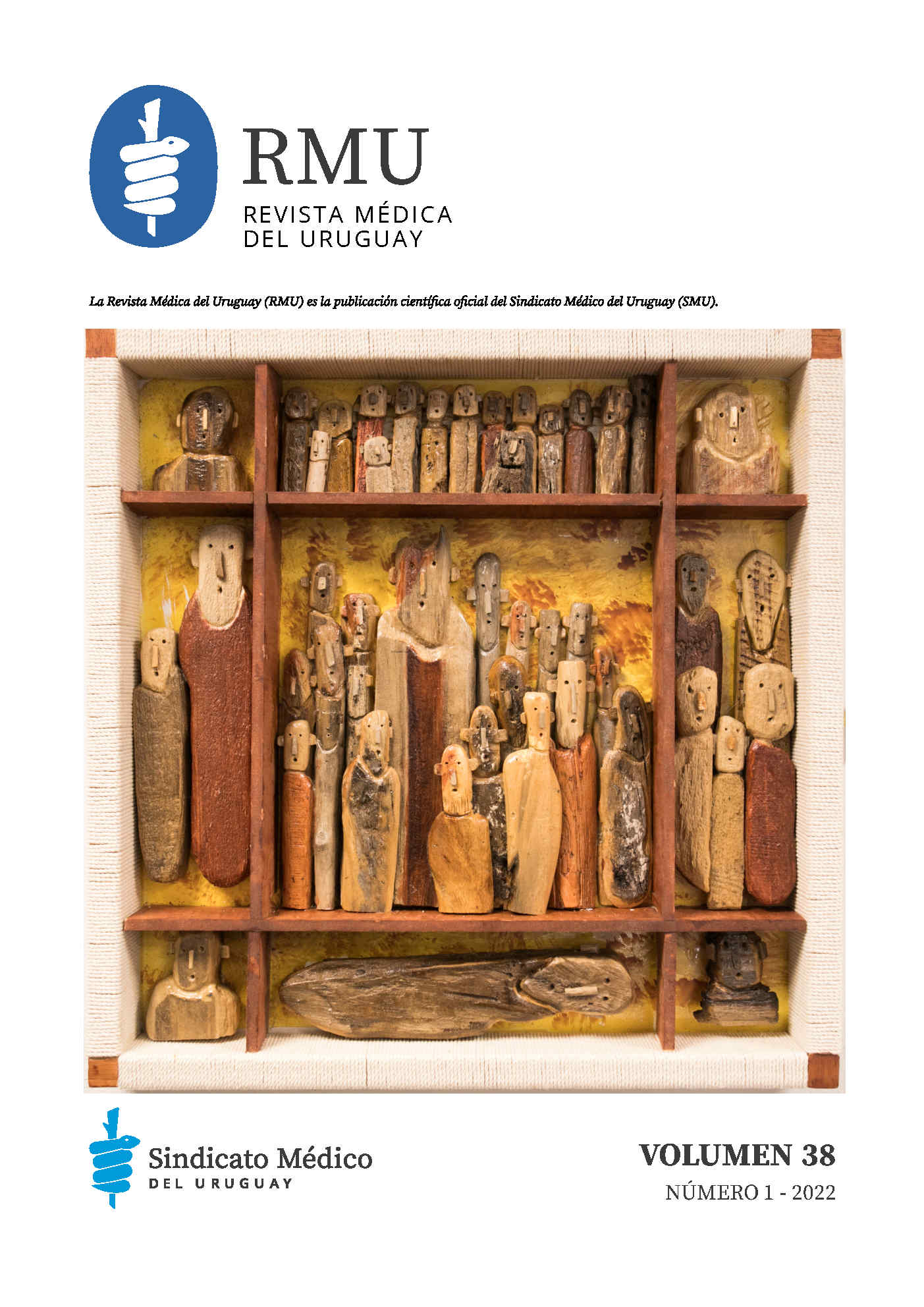Usefulness of Trabecular Bone Score in combination with bone densitometry to assess a series of 194 patients
Abstract
Introduction: most fractures that result from bone fragility occur in the osteopenia range The trabecular bone score (TBS) enables the assessment of microarchitecture aspects that impact bone resistance.
Objective: to describe the clinical characteristics and findings of bone microarchitecture, by applying TBS and bone densitometry in a group of patients.
Method: descriptive study of retrospective collection. Patients who were included in the study underwent a Dual-energy X-ray Absorptiometry (DXA) with TBS at the National Rheumatology Service between July and August, 2020.
Results: 194 patients were analysed, 173 (89%) were female and 21 (11%) were male. 36.1% (70 patients) lay in the osteopenia range, 36.1 (70 patients) in the osteoporotic range. 32.9% (23 patients) with osteopenia and 47.1% (33 patients) with osteoporosis evidenced a degraded bone microarchitecture. 76.9 % of patients with rheumatoid arthritis and 45.8 % of patients with spondyloarthritis respectively evidenced altered bone microarchitecture.
Conclusions: TBS allowed stratification of fracture risk in a significant number of patients, which may suggest it is a useful tool for complementary assessment of bone health.
References
2) Hans D, Goertzen A, Krieg M, Leslie W. Bone microarchitecture assessed by TBS predicts osteoporotic fractures independent of bone density: the Manitoba study. J Bone Miner Res 2011; 26(11):2762-9. doi: 10.1002/jbmr.499.
3) Blanch Rubio J, del Río Barquero L, Olmos Martínez J, Montoya García M, Muñoz Torres M. Revisión de la evidencia científica sobre uso clínico del Trabecular Bone Score (TBS): posiciones oficiales de la SEIOMM (2018). Rev Osteoporos Metab Miner 2018; 10(4):149-59.
4) Shevroja E, Lamy O, Kohlmeier L, Koromani F, Rivadeneira F, Hans D. Use of trabecular bone score (tbs) as a complementary approach to Dual-energy X-ray Absorptiometry (DXA) for fracture risk assessment in clinical practice. J Clin Densitom 2017; 20(3):334-45. doi: 10.1016/j.jocd.2017.06.019.
5) Krohn K, Schwartz E, Chung Y, Lewiecki E. Dual-energy X-ray absorptiometry monitoring with trabecular bone score: 2019 ISCD official position. J Clin Densitom 2019; 22(4):501-5. doi: 10.1016/j.jocd.2019.07.006.
6) Harvey N, Glüer C, Binkley N, McCloskey E, Brandi M, Cooper C, et al. Trabecular bone score (TBS) as a new complementary approach for osteoporosis evaluation in clinical practice. Bone 2015; 78:216-24. doi: 10.1016/j.bone.2015.05.016.
7) Ho-Pham L, Nguyen T. Association between trabecular bone score and type 2 diabetes: a quantitative update of evidence. Osteoporos Int 2019; 30(10):2079-85. doi: 10.1007/s00198- 019-05053-z.
8) Florez H, Hernández-Rodríguez J, Muxi A, Carrasco J, Prieto-González S, Cid MC, et al. Trabecular bone score improves fracture risk assessment in glucocorticoid-induced osteoporosis. Rheumatology (Oxford) 2020; 59(7):1574-80. doi: 10.1093/rheumatology/kez464.
9) Kang K, Kim I, Park S, Hong Y. Associations between trabecular bone score and vertebral fractures in patients with axial spondyloarthritis. Rheumatology (Oxford) 2018; 57(6):1033-40. doi: 10.1093/rheumatology/key027.
10) Siris E, Chen Y, Abbott T, Barrett-Connor E, Miller P, Wehren L, Berger M. Bone mineral density thresholds for pharmacological intervention to prevent fractures. Arch Intern Med 2004; 164(10):1108-12. doi: 10.1001/archinte.164.10.1108.
11) R Core Team. R: a language and environment for statistical computing. Vienna: R Foundation for Statistical Computing, 2020.
12) Puche R. El tejido óseo esponjoso y su evaluación por medio de imágenes. Actual Osteol 2013; 9(3):277-87.
13) Silva B, Leslie W, Resch H, Lamy O, Lesnyak O, Binkley N, et al. Trabecular bone score: a noninvasive analytical method based upon the DXA image. J Bone Miner Res 2014; 29(3):518-30. doi: 10.1002/jbmr.2176.
14) Bousson V, Bergot C, Sutter B, Levitz P, Cortet B. Trabecular bone score (TBS): available knowledge, clinical relevance, and future prospects. Osteoporos Int 2012; 23(5):1489-501. doi: 10.1007/s00198-011-1824-6.
15) Hans D, Barthe N, Boutroy S, Pothuaud L, Winzenrieth R, Krieg M. Correlations between trabecular bone score, measured using anteroposterior dual-energy X-ray absorptiometry acquisition, and 3-dimensional parameters of bone microarchitecture: an experimental study on human cadaver vertebrae. J Clin Densitom 2011; 14(3):302-12. doi: 10.1016/j.jocd.2011.05.005.
16) Muschitz C, Kocijan R, Haschka J, Pahr D, Kaider A, Pietschmann P, et al. TBS reflects trabecular microarchitecture in premenopausal women and men with idiopathic osteoporosis and low-traumatic fractures. Bone 2015; 79:259-66. doi: 10.1016/j.bone.2015.06.007.
17) Ho-Pham L, Nguyen T. Association between trabecular bone score and type 2 diabetes: a quantitative update of evidence. Osteoporos Int 2019; 30(10):2079-85. doi: 10.1007/s00198- 019-05053-z.
18) Neumann T, Lodes S, Kästner B, Lehmann T, Hans D, Lamy O, et al. Trabecular bone score in type 1 diabetes: a cross-sectional study. Osteoporos Int 2016; 27(1):127-33. doi: 10.1007/s00198-015-3222-y.
19) Bréban S, Briot K, Kolta S, Paternotte S, Ghazi M, Fechtenbaum J, et al. Identification of rheumatoid arthritis patients with vertebral fractures using bone mineral density and trabecular bone score. J Clin Densitom 2012; 15(3):260-6. doi: 10.1016/j.jocd.2012.01.007.
20) Richards C, Hans D, Leslie W. Trabecular Bone Score (TBS) predicts fracture in ankylosing spondylitis: the Manitoba BMD Registry. J Clin Densitom 2020; 23(4):543-8. doi: 10.1016/j.jocd.2020.01.003.
21) Hong A, Kim J, Lee K, Kim T, Im S, Kim T, et al. Longterm effect of aromatase inhibitors on bone microarchitecture and macroarchitecture in non-osteoporotic postmenopausal women with breast cancer. Osteoporos Int 2017; 28(4):1413-22. doi: 10.1007/s00198-016-3899-6.
22) Kolta S, Briot K, Fechtenbaum J, Paternotte S, Armbrecht G, Felsenberg D, et al. TBS result is not affected by lumbar spine osteoarthritis. Osteoporos Int 2014; 25(6):1759-64. doi: 10.1007/s00198-014-2685-6.
23) Padlina I, González-Rodríguez E, Hans D, Metzger M, Stoll D, Aubry-Rozier B, et al. The lumbar spine age-related degenerative disease influences the BMD not the TBS: the Osteolaus cohort. Osteoporos Int 2017; 28(3):909-15. doi: 10.1007/s00198-016-3829-7.
24) Martineau P, Leslie W, Johansson H, Oden A, McCloskey E, Hans D, et al. Clinical utility of using lumbar spine trabecular bone score to adjust fracture probability: the Manitoba BMD Cohort. J Bone Miner Res 2017; 32(7):1568-74. doi: 10.1002/jbmr.3124.
25) Martineau P, Leslie W. The utility and limitations of using trabecular bone score with FRAX. Curr Opin Rheumatol 2018; 30(4):412-9. doi: 10.1097/BOR.0000000000000504.

This work is licensed under a Creative Commons Attribution-NonCommercial-ShareAlike 4.0 International License.













